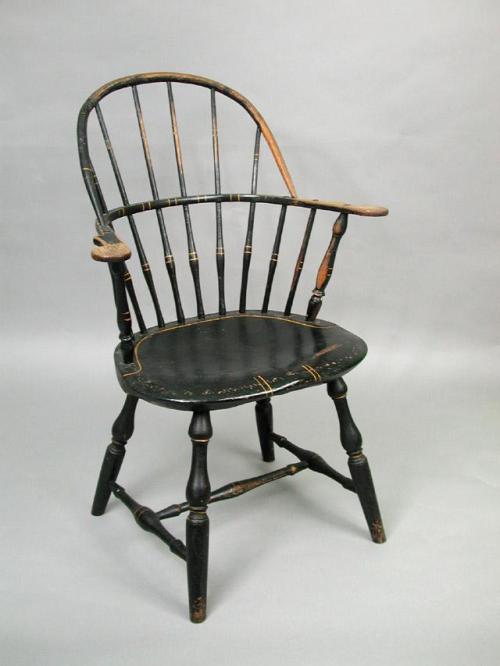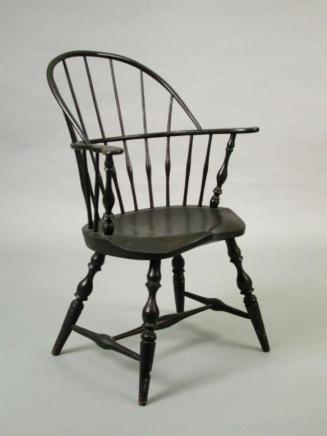Armchair
Original OwnerOriginally owned by
Nathan Fuller
(American)
Furniture MakerMade by
Unknown
Date1790-1800
MediumButternut, maple, ash, oak, black and gold paint
DimensionsPrimary Dimensions (overall height x width x depth): 36 1/8 x 24 1/2 x 21 1/2in. (91.8 x 62.2 x 54.6cm)
ClassificationsFurniture
Credit LineGift of George H. Gilman, Jr.
Object number1983.101.9
DescriptionBlack painted armchair in the Windsor style, with a sack-back, turned posts, legs, and stretchers, and a plank seat. The sack back consists of an arched rail over a horizontal bow, or wooden stick, that encloses six long swelled spindles on the back of the chair and curves forward to form the arms and flat handholds. The swelled spindles have a bulge in the lower half and are tapered up to the top. Each handhold consists of a flat scroll at the front with a stepped profile at the outer side. Each arm is supported by two additional short spindles and a slender post at the front that is turned with baluster forms. The back of the armchair is slanted back; the spindles and posts are joined to the seat in a semi-circular arrangement. The butternut plank seat is oval with a saddled surface, or recessed top surface with a projecting ridge at the front center, and a flat surface at the back where the spindles and posts join the seat. The sides and back of the plank are curved and chamfered, or cut at an angle. Below the seat are four turned maple legs that are raked, or slanted out from top to bottom; each is turned with a baluster form over a tapered ankle and foot. Each side of the chair has a single stretcher with an ovoid form in the center flanked by a tapered form. Between the stretcher is a single medial stretcher, also with the same turnings.
Painted Decoration. The chair is painted black with bands of gold that curve around the front of the arched rail, spindles, posts, legs and stretchers. A painted gold line also outlines the top of the plank seat.
Condition: The left post is repaired or replaced; the shape of the end of each tenon is not consistent with the right post. The black and gold paint is a later addition. The paint is well worn on the arched rail, handholds, spindles and posts. There are multiple small scratches and gouges on the top surface of the seat.
Design and Construction Details: The arched rail is tenoned down through the bow. The arched rail is supported on a through tenon at the top of each of the six spindles that extend through the bow. The bow is supported on each side by through tenons at the top of two spindles and a turned post. The spindles are tenoned down into the spindle platform. The posts are tenoned through the plank seat. The spindle platform is outlined with a narrow groove. The plank is supported on tenons at the top of each leg. The side stretchers are tenoned into the lower legs. The medial stretcher is tenoned into the side stretchers. All the tenons are inserted at an angle, where necessary, to give the proper slant to the bow and each of the spindles and legs.
Painted Decoration. The chair is painted black with bands of gold that curve around the front of the arched rail, spindles, posts, legs and stretchers. A painted gold line also outlines the top of the plank seat.
Condition: The left post is repaired or replaced; the shape of the end of each tenon is not consistent with the right post. The black and gold paint is a later addition. The paint is well worn on the arched rail, handholds, spindles and posts. There are multiple small scratches and gouges on the top surface of the seat.
Design and Construction Details: The arched rail is tenoned down through the bow. The arched rail is supported on a through tenon at the top of each of the six spindles that extend through the bow. The bow is supported on each side by through tenons at the top of two spindles and a turned post. The spindles are tenoned down into the spindle platform. The posts are tenoned through the plank seat. The spindle platform is outlined with a narrow groove. The plank is supported on tenons at the top of each leg. The side stretchers are tenoned into the lower legs. The medial stretcher is tenoned into the side stretchers. All the tenons are inserted at an angle, where necessary, to give the proper slant to the bow and each of the spindles and legs.
Status
Not on view












